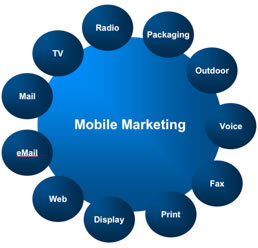Mobile Marketing History | A Brief Rundown
Mobile marketing’s history has taken a long and interesting course. In the bginning, mobile marketing was considered any form of advertising that was mobile. This included bilboards on the back of trucks, advertising on buses, etc. Today, mobile marketing is generally considered to be any advertising that is on mobile electronic devices such as mobile phones and tablets.

Listed here are some important dates that have impacted the course of mobile marketing over the years.
1993: The first mobile phone is mass produced and can send and recieve texts.
1994: QR codes are first invented and used for tracking Toyota production throughout its production process
1999: It is now possible to send SMS texts to users across different mobile networks
2005: The first major SMS campaign by Nike and Pontiac is launched.
2007: Apple Releases its landmark iPhone in the United States which marks the first major touch screen phone with internet capabilities.
2010: QR codes begin to be used widely used for mobile marketing to bring users to a specific mobile website.
2011: Mobile platforms reach an unprecedented $14 billion worth of consumed media on mobile devices.
Mobile marketing today is made up of QR codes, SMS texts, mobile apps, native apps, and mobile websites among others. Modern mobile marketing as we know it began with the iphone when it was released in the U.S. 2007. This is when apps and moblie websites started to take off. In 2011, mobile platform consumers spent about $14 billion on digital media that was available through mobile devices.

QR codes (or Quick Response codes) allow a user to access a URL by scanning a 2D picture, similar to a bar code, that automatically enters in the URL instead of the user having to manually do it. These QR codes were invented by Denso Wave for tracking automobile parts in Japan. QR codes are have been catching on in Europe and Asia but are still slow to catch on in the United States. However, there have been several large scale campaigns based around the QR code by major companies and celebrities in the U.S.
In-game mobile marketing has also been catching on lately. With the growing number of apps being sold that are games, it is only fitting that people start to see marketing within the video game realm. Games are being sposored and and advertisements are being placed by companies to drum up more buisness through these games and apps. This is how apps that gain alot of support from users become so valuable. If an app has 1 million users, then the advertisment that is on that app will been seen by every single one of those users.
Push notifications came along with the invention of the iPhone in 2007. Then they were further popularized by the Android system when it came along. Push notifications allow application owners to more directly communicate with the users in a more efficient and effective manner. Push notificaitons are also relatively cheap in the long run compared to SMS marketing. In the short run, it can be expensive due to application development. However, once the application is developed, it is essentailly free because the only thing it will require is internet bandwith.
Proximity systems, or proximity marketing, relies on SMS-CB to allow messages to be broadcast to all the users of a specific network in a geographic location. This is gaining alot of support, especially in the Philippines. It is used by select government agencies for data gathering and processing for community based programs. It is also used for a commercial service called Proxima, which is a GSM based system that allows users’ mobile devices to be tracked through a shopping center. They can also send out advertisements through a users’ mobile device based on what stores customers stop in and how much time they spend there.
To this day, mobile marketing continues to evolve and grow with the continued refinement of mobile websites and apps being able to produce marketable content and selling this content within the app. This means that this is a growing market and there is alot of money to be made in this evolving $14 billion dollar market per year!





